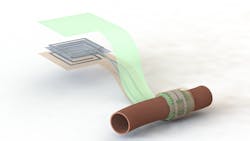Wireless, Battery-Free Sensor Monitors Blood Flow
A new device developed by Stanford University engineers should make it easier for doctors to monitor the success of blood-vessel operations. The sensor monitors the flow of blood through an artery. It is biodegradable, battery-free, and wireless, so it is compact, doesn’t need to be removed in a separate operation, and can warn a patient’s doctor if there is a blockage.
“Measuring blood flow is critical in many medical specialties, so a wireless sensor could help in vascular, transplant, reconstructive and cardiac surgery,” says Paige Fox, assistant professor of surgery.
Monitoring the success of surgery on blood vessels is challenging as the first sign of trouble often comes too late. By that time, the patient often needs additional surgery that carries risks similar to the original procedure. This new sensor could let doctors keep tabs on a healing vessel from afar, creating opportunities for earlier interventions.
The sensor wraps snugly around the healing vessel, where blood pulsing past pushes on its inner surface. As the shape of that surface changes, it alters the sensor’s capacity to store electric charge, which doctors can detect remotely from a device located near the skin but outside the body. That device solicits a reading by pinging the sensor’s antenna, like an ID card scanner. In the future, this device could come in the form of a stick-on patch or be added into a wearable device or smartphone.
The researchers first tested the sensor in an artificial setting where they pumped air through an artery-sized tube to mimic pulsing blood flow. It was also implanted in a rat. Even at such a small scale, the sensor successfully reported blood flow to the wireless reader. Despite the fact the researchers were only interested in detecting complete blockages during these early trials, they did see indications that future versions of the sensor could identify finer fluctuations of blood flow.
The sensor is a wireless version of technology that a Stanford engineer has been developing to give prostheses a delicate sense of touch.
Researchers had to modify the sensor’s materials to make it sensitive to pulsing blood but rigid enough to hold its shape. They also had to move the antenna to a location where it would be secure and unaffected by the pulsation, and to re-design the capacitor so it could be placed around an artery.
The researchers are now investigating way to affix the sensors to the vessels and refining their sensitivity.

